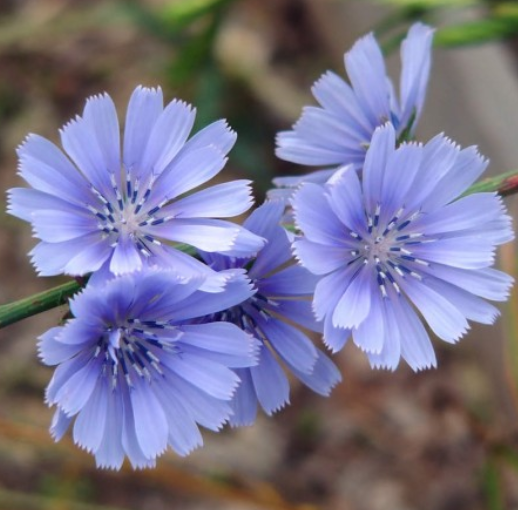Health-Promoting Properties Fresh and dried material is the most commonly used for medicinal purposes [ 1, 30 ]. It is one most important therapeutic plant which belongs to family Asteraceae [15 ]. Various C. in- tybus extracts have demonstrated a wide range of biological and pharmacological properties viz., anti-hyperuricemia, anti-inflammatory, and antidiabetic, anti-nematodal, antioxidant and antiproliferative, hepatoprotective antibacterial antiprotozoal effects [1,8,10,31–34]. The plant also shows laxative, detoxifying, invigorating, blood-cleansing and anti-oxidative properties. Also observed is the diuretic effect, attributed to phenolic acids. In the Unani and Ayurvedic medicine systems the seeds of Cichorium intybus have been used effica- ciously [15 ]. High levels of inulin facilitate the development and maintenance of proper gut microbiota, thus giving the plant a “probiotic” label [2,35,36]. Antiviral Properties The extracts of Cichorium intybus L. showed great anti-viral activity against HSV-1 and partial activity against adenovirus at higher concentrations [ 37 ].
In the study Zhang et al., the anti-hepatitis B property of cichoric acid was evaluated by the D-galactosamine (D-GalN)-induced normal human HL-7702 hepatocyte injury model, the duck hepatitis B virus (DHBV)-infected duck fetal hepatocytes and the HBV-transfected cell line HepG2.2.15 cells, respectively.
This study verifies the anti-hepatitis B effect of cichoric acid from C. intybus leaves, therefore cichoric acid could be used to design the antiviral agents [38]. Since the outbreak of the coronavirus disease (COVID-19) caused by SARS-CoV-2 in December 2019, there has been no vaccine or specific antiviral medication for treatment of the infection where supportive care and prevention of complications is the current management strategy. Shawky et al.
[ 39 ] using a molecular docking method investigated the potential of using medicinal plants in alleviating the novel SARS-CoV-2 infection. A database comprising more than 16,000 compounds was compiled and docked against the crucial viral proteins; 3-chymotypsin protease (3CLpro), papain-like protease (PLpro) and RNA-dependent RNA polymerase (RdRp) to find potential inhibitors for these enzymes.
Molecules 2021, 26, 1814 5 of 14 Furthermore, network pharmacology analysis of all the compounds in the database was attempted to speculate those that can target the inflammatory and immunity-related path- ways at the molecular level and revealing those plants with potential multi-components and multi-targets that may help regulate the body functions and possibly will play a thera- peutic role in the mitigation of the disease. C. intybus was found, along with Glycyrrhiza glabra and Hibiscus sabdariffa among plants with high antiviral potential.
Chicory is a rich source of caffeic acid with antiviral properties. The authors suggest that further in vitro and in vivo analyses are needed to confirm the findings. Nevertheless, chicory was among the plants with potential against SARS-CoV-2 [39–41] Antibacterial and Antifungal Properties Chicory plant was active against gram positive and negative bacteria and yeast. C. intybus extracts inhibits Agrobacterium radiobacter sp. tumefaciens, Erwinia carotovora, Pseudomonas fluorescens, Pseudomonas aeruginosa, Escherichia coli, Staphylococcus au- reus, Staphylococcus epidermidis, Bacillus subtilis, Bacillus thuringiensis, Bacillus subtilis, Salmonella typhi, Micrococcus luteus, Candida albicans, Klebsiella pneumoniae, Enter- obacter cloacae and Streptococcus pyogenes [ 14 –16 , 21, 42 –44 ].
Rahimullah et al. examined ethanol, chloroform, aqueous and hexane extracts from C. intybus seeds against Escherichia coli and Staphylococcus aureus. All extracts showed activity against both organisms but aqueous extracts were more active and show a larger inhibition zone against S. aureus. Hexane, ethanol and chloroform extracts show significant zones of inhibition against both organisms.
The authors of this study suggested that the medicinal plant has significant antibacterial activity and can utilize for the treatment and control of bacterial infections [ 15 ]. Methanolic and aqueous extracts of aerial parts of chicory were also investigated against Escherichia coli, Staphylococcus aureus, Staphylococcus epidermidis, Bacillus subtilis, Pseudomonas aeruginosa, Klebsiella pneumoniae, Erwinia carotovora, Proteus vulgaris, Enterobacter cloacae, Streptococcus pyogenes, and Candida albicans.
The methanol ex- tract exhibited broader antimicrobial spectrum than the aqueous extract compared with the standard antibiotics gentamicin and tobramycin. The water extract showed stronger activity against Staphylococcus epidermidis, Streptococcus pyogenes and Staphylococcus aureus, even more than that of the standard antibiotics [ 16 ]. Antibacterial activity of the water, ethanol and ethyl acetate extracts of C. intybus was investigated by Petrovic et al. All the tested extracts showed antibacterial activity, the ethyl acetate extract being the most active.
A water extract inhibits Agrobacterium radiobacter sp. tumefaciens, Erwinia carotovora, Pseudomonas fluorescens and P. aeruginosa [ 14]. On the other hand, Shaikh et al. studied the antimicrobial properties of seed extracts using ethanol and ethyl acetate against S. aureus, P. aeruginosa, E. coli and C. albicans. All the extracts showed significant antimicrobial activity against the tested microorganism, but S. aureus was found to be most sensitive and had the widest zone of inhibition.
Aqueous extract showed maximum activity against S. aureus while did not show any significant activity against C. albicans. Ethyl acetate extract activity against P. aeruginosa and S. aureus was found to be significant [44 ]. Anti-Protozoal and Antiparasitic Properties C. intybus is a plant with great potential against parasites, both in the context of live- stock and humans [ 5].
This plant synthesizes several bioactive compounds with potential antiparasitic activity, but most studies have been devoted to the role of sesquiterpene lactones (SL). Woolsey et al. demonstrated the efficacy of chicory leaf and root extracts against Cryptosporidium parvum, with the lower SL extract (leaf) showing greater inhibition.
Based on the results, the authors suggest that the antiparasitic activity does not appear to be related only to the SL content [45]. Marley et al. conducted a study on lambs that acquired parasites by natural transmission. The effects of chicory on total helminth parasites showed that this forage reduced the number of adult abomasal helminth parasites in lambs [46].





Reviews
There are no reviews yet.